Enjoy the serene elegance of a traditional Japanese tea ceremony at Kyoto Maikoya Gion. This 5-star rated experience allows up to six travelers to don a beautiful kimono and learn the etiquette and significance behind this revered cultural ritual. Priced at just $62.17 per person, it’s a chance to step into a world of mindfulness and respect, all within a short walk from Gion Shijo station. What secrets might this enchanting ceremony unveil?
Key Points
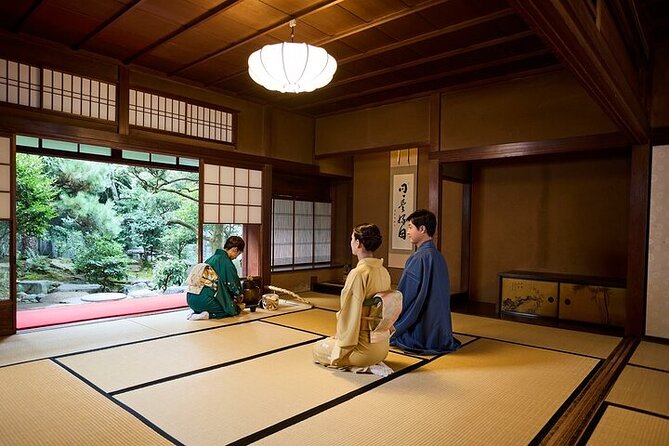
- Located in Gion, Kyoto, the Maikoya Gion offers a traditional kimono tea ceremony experience for up to 6 travelers.
- The 5-star rated experience includes green tea service, kimono costume, and a guided tea ceremony by an expert.
- The meeting point is a 10-minute walk from Gion Shijo station, near the historic Rokuharamitsuji Temple.
- The tea ceremony highlights the cultural significance of mindfulness, attention to detail, and harmonious interaction between host and guest.
- The experience is suitable for tea enthusiasts and those interested in exploring Japanese traditions.
Experience Overview

The Kimono Tea Ceremony in Kyoto offers visitors a unique opportunity to enjoy Japanese cultural traditions.
Located at Kyoto Maikoya Gion, the experience can accommodate up to 6 travelers at a time. Priced from $62.17 per person, the 5-star rated activity includes a green tea service, a kimono costume, and a tea ceremony guide.
The meeting point is a 10-minute walk from Gion Shijo station, near Rokuharamitsuji Temple. Confirmation is provided at booking, and free cancellation is available up to 24 hours prior.
The experience isn’t wheelchair accessible, and children under 7 aren’t permitted.
You can also read our reviews of more tours and experiences in Kyoto.
Inclusions
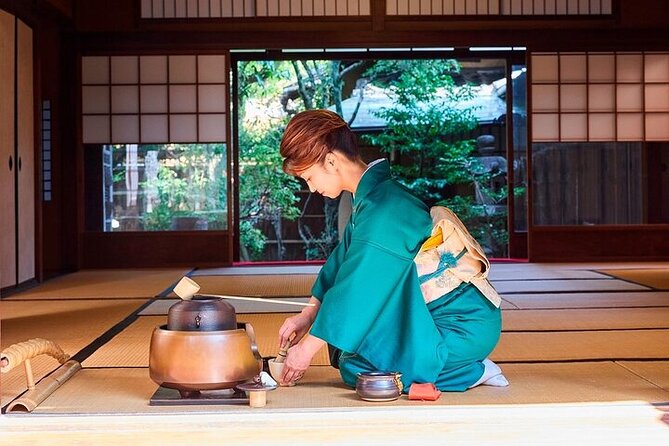
As part of the Kimono Tea Ceremony experience, travelers can expect to enjoy a serving of green tea and wear a traditional kimono costume.
The tea ceremony guide will lead the group through the cultural ritual, ensuring participants understand the significance and etiquette.
The package also includes hotel pickup and drop-off, making the experience convenient and hassle-free.
Whether you’re a tea enthusiast or simply interested in enjoying Japanese tradition, the Kimono Tea Ceremony offers a unique and memorable cultural encounter in the heart of Kyoto.
Transportation Details
Travelers can find the meeting point at KIMONO TEA CEREMONY MAIKOYA in the Gion Kiyomizu area, which is a 10-minute walk from the Gion Shijo station and near the Rokuharamitsuji Temple.
The experience ends back at the meeting point. Notable transportation details include:
- Convenient location near public transportation
- Easy walking distance from the station
- Nearby historic temple landmark
- Suitable for independent travelers
- Straightforward return to starting point
Booking Information
Confirmation is received at the time of booking for this Kimono Tea Ceremony experience.
Free cancellation is available up to 24 hours before the event. Travelers can reserve now and pay later.
A maximum of 5 people can book through Viator, though other sites may allow more participants.
The experience isn’t wheelchair accessible, and children under 7 aren’t permitted in the tea ceremony venue.
It’s conveniently located near public transportation.
The Tea Ceremony
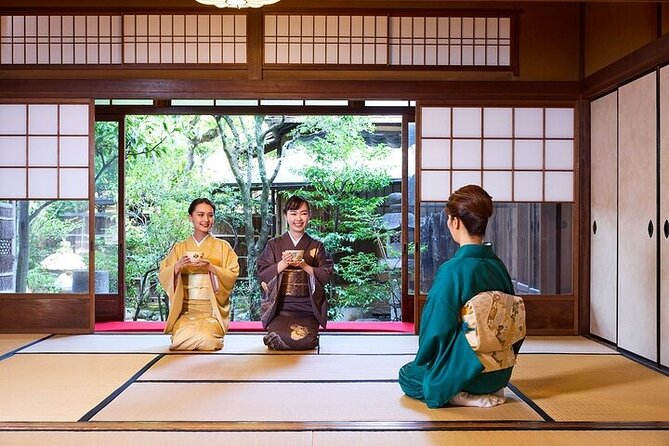
Attendees are escorted to the traditional tea ceremony room, where they don their ornate kimono costumes under the guidance of the tea ceremony experts.
The ritual unfolds with graceful movements and precise steps:
- The host prepares the matcha green tea with ceremonial tools and utensils
- Guests admire the artful ceramic bowls and sweets accompanying the tea
- Participants silently observe the host’s actions, learning about the history and symbolism
- They each take turns sipping the frothy, earthly tea in a specific order
- The experience culminates in lively discussion about the cultural significance of the tea ceremony.
Kimono Attire
After seeing the serene tea ceremony, participants don vibrant kimono costumes that transport them deeper into Japan’s captivating cultural heritage. Carefully selected from an array of styles, the kimono’s intricate patterns and vivid colors reflect the rich tapestry of Japanese artistry. Adorned in these elegant garments, guests seamlessly blend with the traditional ambiance, enhancing their overall immersive experience.
| Style | Color | Fabric |
|---|---|---|
| Furisode | Vibrant red | Silk |
| Homongi | Muted pastels | Brocade |
| Yukata | Soft indigo | Cotton |
Embodying the essence of Japanese aesthetics, the kimono attire elevates the tea ceremony, creating a truly unforgettable cultural encounter.
Cultural Significance
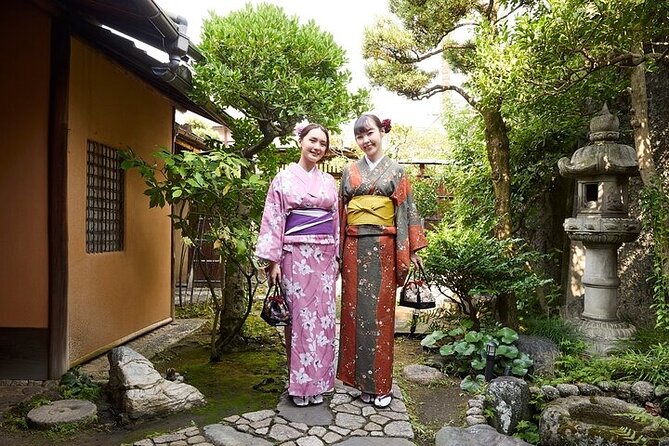
The tea ceremony is a deeply revered tradition in Japanese culture, offering participants a rare opportunity to enjoy the refined elegance and spiritual tranquility that permeate this centuries-old practice.
The cultural significance of the Kimono Tea Ceremony lies in its emphasis on:
- Mindfulness and present-moment awareness
- Respect for tradition and attention to detail
- Reverence for nature and seasonal changes
- Harmonious interaction between host and guest
- The cultivation of inner peace and a sense of serenity
Participating in this immersive experience allows visitors to gain a deeper understanding and appreciation of Japanese cultural heritage.
Recommended Attire
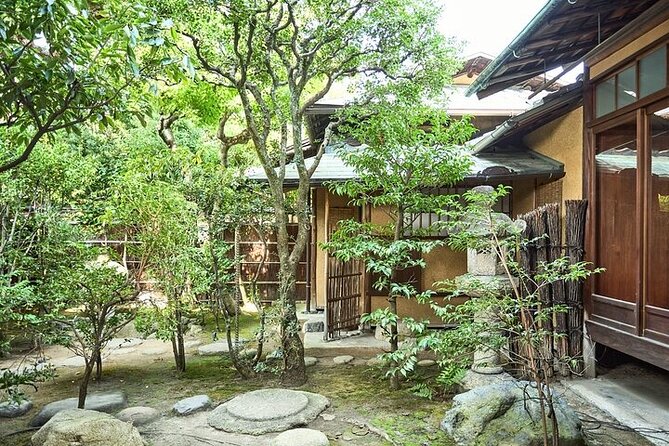
Proper attire is an integral part of the Kimono Tea Ceremony experience. Participants are expected to wear the provided traditional Japanese kimono during the event.
These elegant robes are carefully selected and fitted to ensure a culturally authentic atmosphere. Comfort is also essential, as the ceremony involves sitting on the floor for an extended period.
Attendees should wear socks or stockings, as shoes are removed before entering the tea room. The kimono and accessories are professionally arranged by the staff, allowing guests to fully enjoy the traditional Japanese ritual.
Proper attire enhances the overall experience.
Frequently Asked Questions
What Is the Minimum Group Size for This Experience?
The minimum group size for this experience is 1 person. According to the information provided, the experience can accommodate a maximum of 6 travelers, indicating that the minimum group size is a single participant.
Can Participants Take Photos or Videos During the Tea Ceremony?
Participants can take photos and videos during the tea ceremony, but they’re advised to be respectful and avoid disrupting the experience. Photography and filming may be restricted at certain stages of the ceremony.
Is There an Option to Extend the Duration of the Experience?
The experience duration cannot be extended. The tour lasts a maximum of 6 travelers and the price is fixed at $62.17 per person. Participants are not allowed to take photos or videos during the tea ceremony.
Is This Activity Suitable for People With Physical Disabilities?
The activity is not wheelchair accessible, according to the additional information provided. However, it may be suitable for people with some physical disabilities if they can navigate the tea ceremony venue. Visitors should inquire about accommodations when booking.
Can Participants Purchase the Tea or Other Items Used in the Ceremony?
Participants can’t purchase the tea or other items used in the ceremony. The experience is limited to the green tea served during the tea ceremony, which is included in the price. No additional purchases are available.
Recap
The kimono tea ceremony at Kyoto Maikoya Gion offers a unique cultural experience. Participants will don traditional Japanese attire, sip green tea, and learn about the ceremony’s significance and etiquette from expert guides. With a serene atmosphere and convenient location, this 5-star rated activity provides an immersive glimpse into Japan’s rich heritage. It’s a must-do for travelers seeking an authentic cultural encounter in Kyoto.
More Tour Reviews in Kyoto
- The Art of Geisha: Exclusive Show & Traditional Japanese Game
- Tea Ceremony With Kimono and Professional Photoshoot in Kyoto
- Kyoto Arashiyama Bamboo Forest Hidden Hiking Tour
- Kyoto Early Morning Walking Tour: Nature & History
- Small-Group Dinner Experience in Kyoto With Maiko and Geisha
- Private Kyoto Night Tour: Historic Walk at Gion and Fushimi
Not for you? Here's more things to do in Kyoto we have recnetly reviewed
- 5 Best Cruises And Boat Tours In Kyoto
- 14 Best Dining Experiences In Kyoto
- 20 Best Full-Day Tours In Kyoto
- 5 Best 2 Day Tours In Kyoto
- 2 Best 4 Day Tours In Kyoto
- 20 Best Photography Experiences In Kyoto
- 13 Best Dinner Tours In Kyoto
- 25 Best Food Tours In Kyoto
- 14 Best Lunch Experiences In Kyoto
- Kyoto Bus Tour: Iconic KInkakuji, Ginkakuji, Kiyomizu Temple (AW)
- Kyoto Bus Tour: Arashiyama, Kinkaku-ji Review
- Gyoza Cooking Class in Kyoto: Traditional Japanese Dumplings
